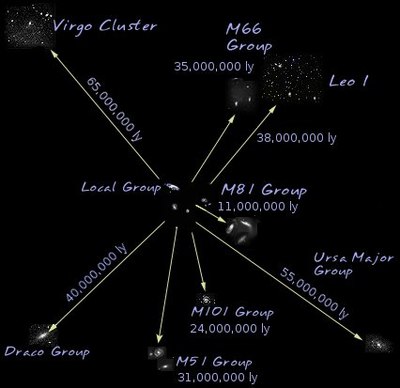Thoughts
21
Last
week we started a mental journey through the solar system, out
through our galaxy and on into the local cluster of galaxies to look
back at the living organism Earth. That trip took us 3.5 million
years traveling at the speed of light and we did not make it to the
edge of our Local Cluster. Larger than local clusters are
super-clusters.
Let's go and look at some more of the universe. As we leave Local
Cluster we can again look back and see that the galaxies are moving
in a way that looks somewhat synchronized. All the galaxies of the
local group are moving in relation to their center of mass. The mass
of the galaxies have warped the fabric of space/time in such a way
that they are caught in each others gravity.
Scanning
to see what is in front and to the sides of us we see other larger
groups of galaxies; super-clusters. Our Local Group is part of the
Virgo Super-cluster, which includes the Virgo cluster.
 *
*
The
clusters that make up super-clusters are moving in relation to their
center of mass, so I am going to project the super-cluster groups are
moving in relation to each other.
To
my knowledge the whole of the visible universe has not been mapped
but the above and what I have read, leads me to believe all mass is
probably interconnected in space/time; maybe with space/time.
Now we have covered hundreds of millions possibly a few billion light years, so I am feeling old.

Galactic
Metropolis
The
collection of red dots seen near the center of this image show one of
several very distant galaxy clusters discovered by combining
ground-based optical data from the National Optical Astronomy
Observatory's Kitt Peak National Observatory with infrared data from
NASA's Spitzer Space Telescope. This galaxy cluster, named ISCS
J1434.7+3519, is located about 9 billion light-years from Earth.
The
large white and yellow dots in this picture are stars in our galaxy,
while the rest of the smaller dots are distant galaxies. The cluster,
comprised of red dots near the center, includes more than 100 massive
galaxies.
Spitzer
was able to capture prodigious levels of star formation occurring in
the galaxies that live in this cluster. Some of them are
forming stars hundreds of times faster than our own Milky Way galaxy.
Infrared
light in this image has been colored red; and visible light, blue and
green.
Image
credit: NASA/JPL-Caltech/KPNO/University of Missouri-Kansas City
**
No comments:
Post a Comment